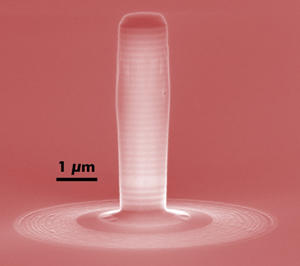
Colorized image of a NIST micropillar containing a semiconductor quantum dot that emits individual photons, or particles of light. A NIST micropillar like this was used in research led by the University of Toronto that recreated paths of light through two slits, updating a famous "double slit" experiment that contributed to the development of quantum theory.
A quantum dot made at the National Institute of Standards and Technology (NIST) has helped an international team of researchers "see" the inner workings of quantum mechanics without disturbing the process—an achievement long considered impossible.
The research, led by a University of Toronto physicist and published in the June 3 issue of Science,* applied a modern measurement technique to an historic experiment in which a beam of light takes different paths through two slits, creating a wavelike interference pattern on a screen behind. The original experiment suggested, among other things, that light acts as both particles (photons) and waves. This experiment contributed to the early development of quantum theory, the often-curious rules governing the behavior of matter and light.
Ordinarily, measuring the position of a photon disturbs its momentum, and vice versa. Thus, it is generally impossible to determine which slit a photon passes through without changing the interference effects—that is, to measure both the particle and wave behavior at the same time. But in the new experiments, researchers used "weak measurement" techniques to gain some information about the photons' paths without disturbing the interference pattern, thus maintaining light's dual identity as both particle and wave. By repeating the measurements many times and combining the results, researchers reconstructed the photons' paths as they passed through the slits, as well as the probabilities of taking each path.
NIST researchers created the photon source, a quantum dot made of indium gallium arsenide. A quantum dot is a nanoscale bundle of semiconductor materials that behaves like a single atom electronically. The NIST quantum dot was embedded in an optical cavity within a microscale pillar to direct photons in the desired direction (see image). The dot is excited continuously by a laser and, each time it relaxes, emits an individual infrared photon. NIST is a leader in the development of single-photon sources.
- Laura Ost
* S. Kocsis, B. Braverman, S. Ravets, M.J. Stevens, R.P. Mirin, L.K. Shalm, and A.M. Steinberg. Observing the average trajectories of single photons in a two-slit interferometer. Science 332, 1170 (2011), June 3.

